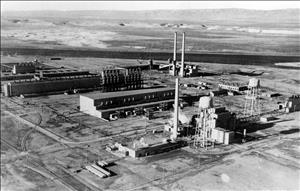On August 6, 1945, when President Harry Truman (1884-1972) announces the atomic bombing of Hiroshima that day, the residents of Richland discover the truth about what they have been producing at Hanford. The news of the atomic bombing is accompanied by another bombshell for residents of Washington: Key atom bomb components were produced at the super-secret Hanford Engineer Works just north of Richland. Many Richland residents only now learn exactly what they have been making since 1943.
Something Big
For two years, Washington residents knew that something big was going on at Richland and Hanford. The population of this dusty, sagebrush area had mushroomed to more than 40,000 workers at its peak. Yet even most of the workers themselves did not know exactly what they were building.
"Guesses ranged from a new rocket bomb to a derivative of nylon," said the Spokane Daily Chronicle the day the news came out of the Hiroshima bomb. "Tongues wagged, workmen talked, nearly every truck driver who passed that way had his pet theory. Many may have guessed the correct answer. But still the riddle of Hanford remained, and the secret was kept" ("Hanford Secret").
"I did not want to know," said a Richland police officer. "If a person knew too much he might land in jail. I don't care what it is as long as it smashed the Japs" ("Eleven Ghosts"). "We knew it was a secret project and we asked no questions," a "typical" Richland wife was reported as saying ("Eleven Ghosts").
The chief of construction said not more than 1 percent of the workers had any idea what was really going on.
"It's Atomic Bombs"
That all changed when President Harry Truman specifically mentioned Hanford in announcing the August 6, 1945, atomic bomb attack on the Japanese city of Hiroshima.
"It's Atomic Bombs" blared headlines in Richland's weekly newspaper The Villager and in The Pasco Herald that day. Later it was determined that the plutonium in the atomic bomb dropped on Nagasaki, Japan, on August 9, three days after the Hiroshima bombing, as well as that in an earlier test bomb, was manufactured at Hanford, although not the plutonium in the Hiroshima bomb.
Hanford officials declared that their part in ending the war was a source of pride and satisfaction. Most of the workers agreed. Some, however, were already beginning to worry about whether the "keepers of the secret will use it only for the good of mankind and never for vain or selfish purposes" (Kubik).

